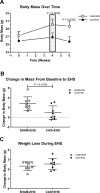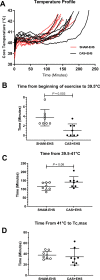The impact of castration on physiological responses to exertional heat stroke in mice
- PMID: 36227921
- PMCID: PMC9560521
- DOI: 10.1371/journal.pone.0275715
The impact of castration on physiological responses to exertional heat stroke in mice
Abstract
Introduction: The capability of male mice to exercise in hot environments without succumbing to exertional heat stroke (EHS) is markedly blunted compared to females. Epidemiological evidence in humans and other mammals also suggests some degree of greater vulnerability to heat stroke in males compared to females. The origins of these differences are unknown, but testosterone has previously been shown to induce faster elevations in core temperature during acute, passive heat exposure. In this study, we tested the hypothesis that loss of testosterone and related sex hormones through castration would improve the performance and heat tolerance of male mice during EHS exposure.
Methods: Twenty-four male mice were randomly divided into 3 groups, untreated EHS mice (SHAM-EHS), castrated EHS mice (CAS+EHS) and naïve exercise controls (NAIVE). Exercise performance and physiological responses in the heat were monitored during EHS and early recovery. Two weeks later, blood and tissues were collected and analyzed for biomarkers of cardiac damage and testosterone.
Results: Core temperature in CAS+EHS rose faster to 39.5°C in the early stages of the EHS trial (P<0.0001). However, both EHS groups ran similar distances, exhibited similar peak core temperatures and achieved similar exercise times in the heat, prior to symptom limitation (unconsciousness). CAS+EHS mice had ~10.5% lower body mass at the time of EHS, but this provided no apparent advantage in performance. There was no evidence of myocardial damage in any group, and testosterone levels were undetectable in CAS+EHS after gonadectomy.
Conclusions: The results of these experiments exclude the hypothesis that reduced performance of male mice during EHS trials is due to the effects of male sex hormones or intact gonads. However, the results are consistent with a role of male sex hormones or intact gonads in suppressing the early and rapid rise in core temperature during the early stages of exercise in the heat.
Conflict of interest statement
The authors have declared that no competing interests exist.
Figures





Similar articles
-
Ovariectomy aggravates the pathophysiological response to exertional heat stroke in mice.J Appl Physiol (1985). 2023 May 1;134(5):1224-1231. doi: 10.1152/japplphysiol.00092.2023. Epub 2023 Apr 6. J Appl Physiol (1985). 2023. PMID: 37022961 Free PMC article.
-
Delayed metabolic disturbances in the myocardium after exertional heat stroke: contrasting effects of exertion and thermal load.J Appl Physiol (1985). 2023 Nov 1;135(5):1186-1198. doi: 10.1152/japplphysiol.00372.2023. Epub 2023 Oct 5. J Appl Physiol (1985). 2023. PMID: 37795530 Free PMC article.
-
Delayed metabolic dysfunction in myocardium following exertional heat stroke in mice.J Physiol. 2020 Mar;598(5):967-985. doi: 10.1113/JP279310. Epub 2020 Feb 19. J Physiol. 2020. PMID: 32026469
-
Controversies in exertional heat stroke diagnosis, prevention, and treatment.J Appl Physiol (1985). 2019 Nov 1;127(5):1338-1348. doi: 10.1152/japplphysiol.00452.2019. Epub 2019 Sep 23. J Appl Physiol (1985). 2019. PMID: 31545156 Review.
-
Exertional heat stroke: an evidence based approach to clinical assessment and management.Exp Physiol. 2022 Oct;107(10):1172-1183. doi: 10.1113/EP090488. Epub 2022 Jul 13. Exp Physiol. 2022. PMID: 35771080 Review.
Cited by
-
Ovariectomy aggravates the pathophysiological response to exertional heat stroke in mice.J Appl Physiol (1985). 2023 May 1;134(5):1224-1231. doi: 10.1152/japplphysiol.00092.2023. Epub 2023 Apr 6. J Appl Physiol (1985). 2023. PMID: 37022961 Free PMC article.
-
Protective Effect of Curculigo orchioides Gaertn. Extract on Heat Stress-Induced Spermatogenesis Complications in Murine Model.Curr Issues Mol Biol. 2023 Apr 7;45(4):3255-3267. doi: 10.3390/cimb45040212. Curr Issues Mol Biol. 2023. PMID: 37185736 Free PMC article.
-
Exertional heat stroke causes long-term skeletal muscle epigenetic reprogramming, altered gene expression, and impaired satellite cell function in mice.Am J Physiol Regul Integr Comp Physiol. 2024 Feb 1;326(2):R160-R175. doi: 10.1152/ajpregu.00226.2023. Epub 2023 Dec 4. Am J Physiol Regul Integr Comp Physiol. 2024. PMID: 38047316 Free PMC article.
References
-
- Update: Heat illness, active component, U.S. Armed Forces, 2020. MSMR. 2021;28: 10–15. - PubMed
Publication types
MeSH terms
Substances
LinkOut - more resources
Full Text Sources
Miscellaneous

